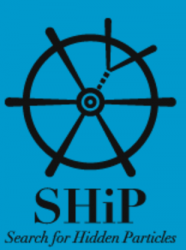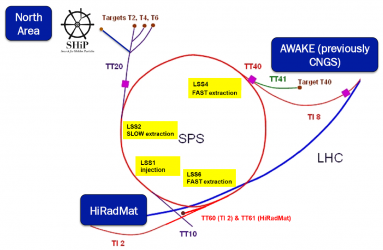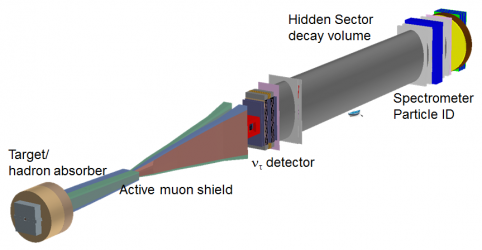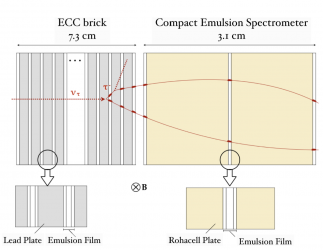The SHiP project at CERN - a new ship to seek for invisible particles
With the post of today, I want to discuss another of the future projects that could be part of the particle physics experimental landscape of the next decades: the SHiP project. This is totally different form the FCC option that I discussed here, and the physics goals are totally different.
The project called SHiP (note the non-capitalized ‘i’) aims to search for hidden or invisible particles, like particles that are potential candidates for the dark matter assumed to be present in our universe.
THE NAME AND THE NUTSHELL

[image credits: SHiP @ CERN]
As a starter (and an appetizer), let us spend a few minutes on the name of this experiment. In many other posts (also from others), I emphasized the way in which scientists were sometimes not so imaginative in finding names and acronyms for their experiments or discoveries.
SHiP belongs to the exception as the acronym is in my opinion good. It comes from ‘Search for Hidden Particles’. What I find cool is that the acronym tells exactly what the experiment aims to do. Nothing less nothing more.
The SHiP experiments is a proposal for a new experimental facility to be located at CERN whose aim is to search for hidden particles. As I said, the acronym tells everything! And I have not told you anything new so far :)
But what are those so-called hidden particles? They appear in many theories for physics beyond the Standard Model of particle physics, and could for instance incarnate dark matter particles, be sterile neutrinos in neutrino models, some supersymmetric particles with specific properties (see here for a general introduction on supersymmetry), axions and even more.
Those particles are all neutral and weakly-interacting particles that are in addition long-lived. Those are predicted in many models (as I tried to emphasize above) and can actually be produced at the LHC but not detected. They are invisible due to their properties: they will in fact decay outside the LHC detectors.
How does this work more in details?
These particles interact with such a weak rate that this makes them long-lived. They will be able to fly without interacting with anything around, or decaying through a typical LHC detector. As they are neutral, one needs to wait for their decay to observe anything, in contrast with charged particles that can easily interact with the detector material. As a result, this is why they are said invisible.
As these particles are very weakly interacting, the decay will occur, but only after a long time. That is why one needs a huge detector to be able to observe something, and reconstruct the hidden particles.
The SHiP facility has been designed to observe these decays.
A BEAM DUMP EXPERIMENT

[image credits: CERN]
The SHiP experiment is what is called a beam dump experiment. It takes a proton beam extracted from the SPS machine, one of the pre-accelerators of the Large Hadron Collider (the LHC).
This is illustrated on the little map on the right where the blue line is the LHC, the red circle the SPS and SHiP is shown on the top of the figure.
The 6.5 TeV protons used for the LHC experiments are in fact processed via a series of pre-accelerators, the SPS being one of them. The energy of the protons extracted of the SPS equals 400 GeV, i.e. it is high but still more than 15 times less than the protons of the LHC.
Those already very high energetic protons (their energy equals 400 times their mass) are then injected into the SHiP apparatus where they will be smashed onto a target that is fixed (which contrasts with a collision such as the one occurring at the LHC where we have two moving beams).
In five years of running, 2 x 1020 protons are expected to be delivered to SHiP.
The idea behind this experiment is that the target is very heavy, and thus capable to stop the proton beam. The target is hence capable to contain the entire fragmentation process of the proton beam, which generates a plethora of particles that all need to be stopped.
We really need to be sure that only the hidden particles survive!
GETTING RID OF UNINTERESTING REMNANTS

[image credits: CERN]
While the proton beam is stopped by the target, secondary particles can actually go through it. As these are not interesting for hidden particle searches, an iron device has been put right after the target (in green on the above picture) so that it could absorb all of them.
Similarly, in the case a proton would not be interacting with the target and would thus go through it, the iron absorber will … absorb it.
On top of that, magnets are also present so that muons can be deflected and send far away from the detector. This consists of a 50m long muon shield. The size is huge but necessary for the study.
Let me emphasize it once more: to study hidden particles, we need to get rid of anything else, in particular any Standard Model particles.
At this stage, only neutrinos survive. And this is a cool feature: we can also use SHiP to study neutrinos!
NEUTRINOS PHYSICS WITH SHIP

[image credits: SHiP collaboration]
After the hadron absorber and the muon shield, the apparatus contains a tau neutrino detector (in red on the above picture) so that neutrino physics could be studied at SHiP.
The main goal is to perform the first direct observation of the tau antineutrino, using a technology that is not crazy: it is the one already employed in the OPERA experiment that observed a bunch of tau neutrino candidates.
One detector cell, made of several emulsion chambers separated by lead plates, is shown on the left. Emulsion films are used as a micrometer-precise tracker. They allows for reconstructing the trajectories of the particles, their momenta, measure their charge, etc.
SHiP is expected to measure the properties of 7000 tau neutrinos and 3500 tau antineutrinos in five years. These numbers may sound small, but this is actually a huge statistics for neutrino physics. Let me recall that we have only observed 5 tau neutrinos at all so far.
All of this will thus allow for a plethora of measurements allowing high-energy physicists to further corner the properties of the (anti)neutrinos.
DETECTING HIDDEN PARTICLES
And now the main meat. After a few shields to absorb what could come out of the neutrino detector comes the big cylinder detector shown on the above picture.
As already said, the main goal of the SHiP facility is to detect the so-called hidden particles, i.e., hypothetical particles that are capable to fly without interacting through standard detectors. The key word is standard: let build a hidden particle detector far from being a standard LHC detector.
In order to be sensitive to the presence of such particles, there is only one way out: we need a huge detector.
The cylindric detector is 62m long and has an elliptical section with a width of 5m and a height of 10m. In it, vacuum only! The vacuum inside corresponds to pressure of 0.000001 times the atmospherical pressure.
This detector comes with a lot of device (see on the detector picture above) allowing to observe the decay of any hidden particle that would be produced at the time of the beam dump and reconstruct its properties. In typical theories with hidden particles, the latter are expected to decay back into particles of the Standard Model like electrons, muons, kaons, pions or photons. And these can be precisely detected in SHiP thanks to its huge dimensions.
The major issue to a potential observation is the background (neutrinos, cosmic muons, etc.). The SHiP detector is such than one expect less than 0.1 background event during the five years of running. For this reason, it is perfect to satisfy its physics goals! If we observe anything, we will be sure this will be a new phenomenon.
SUMMARY
In this post, I briefly presented the SHiP experiment, a new facility designed to observe hidden sector particles, particles that are predicted in numerous extensions of the Standard Model of particle physics. Even if these particles are in principle easily produced at the LHC, they are not easily detected and actually invisible.
Their detection therefore requires a special apparatus. This is what SHiP is about. The experiment is built in such a way that hidden particles can be produced, and detected in an almost background-free environment.
Now, we just need to hope this will be ever built! :)
Great article. Thank you! I'm very optimistic about this field of science. We are living in exciting times.
I am too :)
Filled with wonderful info, this is great post. Highly recommended. Good work.
Thanks a lot!
It's probably 10 years too early to ask, but will we see work from this in the BOINC network/LHC@home?
I am not involved in those so that it will be hard to tell (those projects are more on the experimental side and I am a theorist). Sorry.
No problem. You can only get answers if you ask questions after all ;)
You know the difference between a theoretical physicist and a practical?
If a heavy weight drops on their feet, the Theorist wonders if he should feel pain or if the weight should not be felt by his feet because it should pass through - and the Practical asks his foot if it has measured the pain and weight correctly.
Then the BOINC community comes and says "we got 2/3 results that the weight missed your feet, so stop worrying".
that's a good one :)
More seriously, these two are actually two different (but connected) fields today.
Downvoted to counteract @thejohalfiles and bots.
More info here: https://steemit.com/test/@abit/whales-no-up-voting-test
Thanks for letting me know. I understand.